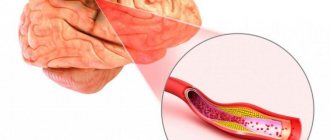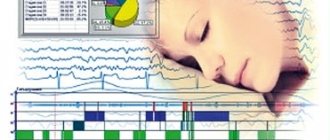The brain is the most complex structure of the human body. Many metabolic processes occur in it and when they are disrupted, various pathological processes develop, one of which is cerebral atherosclerosis or cerebral atherosclerosis.
This disease is assigned the ICD 10 code – 167.2. This dangerous disease of the cerebral artery belongs to the cerebrovascular type of disease and is characterized by a narrowing of the lumen of blood vessels, which results in a stroke, profound disability or death.
Symptoms of cerebral atherosclerosis
If a patient has cerebral vessels affected by atherosclerosis, symptoms and treatment can be quite varied. However, there are a number of manifestations of this disease that are common to most cases.
- The initial stage of the disease is characterized by negative changes in the psyche. The patient becomes irritable, often experiences neuroses, depressive moods, gets tired quickly, and feels inhibited. Unreasonable headaches occur, the head sometimes becomes heavy, and sometimes a pressing feeling appears. And the main symptom is memory impairment: first, the patient has difficulty remembering new information, and then cannot remember past events.
- Then atherosclerosis of the cerebral vessels manifests itself in the form of more serious mental disorders. Patients are constantly concerned about their own state of health and suspect various pathologies. Delusions of persecution often occur, and sensitivity to external factors (stress) increases. New physiological symptoms appear: tingling, burning in different parts of the body.
- In an advanced state, the patient practically loses the ability to care for himself, and dementia develops. The patient does not remember new information, although he can still remember past events. He is disoriented in time and space, and therefore requires constant supervision. Transient ischemic attacks occur with disorders of speech, vision, and sensitivity. Circulatory disorders in the brain lead to spasms and strokes.
Yellow, white and vulnerable
The morphological “carrier” of atherosclerosis is the so-called atherosclerotic
plaques: dense formations of round or oval shape, white or yellowish-white, which, rising above the surface of the inner lining of the vessels, narrow their lumen. Most often, fibrous plaques are found in the abdominal aorta and its branches, as well as in the arteries of the heart, brain, kidneys, lower extremities, carotid arteries, etc.
The term “atherosclerosis” was proposed by the German pathologist F. Marchant in 1904 to define a disease in which arterial sclerosis is caused by impaired metabolism of lipids (fats) and proteins. The word ATHEROSCLEROSIS is made up of the Greek roots “ather” (mush) and “sclerosis” (hardening). These words, so polar in meaning, very accurately reflect the pathological processes characteristic of this disease: the accumulation of soft deposits, the proliferation of connective tissue and calcification, as a result of which the arteries become compacted and stiff.
In the early stages, the plaque is a thin connective tissue capsule containing a lot of lipids. These are the so-called yellow ones
, or
vulnerable
, plaques. The last name is very accurate, since the thin shell of these plaques can be damaged as a result of the action of both hemodynamic factors (pressure changes in the vessel) and special proteins produced by cells of the immune system that are located near the capsule shell.
When the capsule ruptures, the released fatty substances come into contact with platelets and blood cells, which leads to the immediate formation of a blood clot. In addition, biologically active substances released by platelets can cause coronary artery spasm. As a result, acute coronary syndrome develops - unstable angina or myocardial infarction, in some cases causing sudden death.
As a result of necrosis (death) of the deep layers of the vessel wall, an aneurysm can form, that is, a protrusion of the wall. Often the blood peels off the inner lining of the vessel from the middle layer, and then so-called dissecting aneurysms
.
Such complications carry the risk of rupture of either the aneurysm itself or the vessel wall. When an atherosclerotic plaque ruptures, biologically active substances released by platelets can lead to spasm of the coronary artery - and then unstable angina develops (small-focal myocardial infarction with parietal thrombosis of the coronary artery) or large-focal myocardial infarction.
Sometimes, due to necrosis of the deep layers of the vessel wall, an aneurysm (protrusion) is formed, which can lead to rupture of the wall. All these processes can cause sudden death. In the later stages of development, fibrous plaques are dense formations with a strong connective tissue capsule and a relatively low lipid content - the so-called white plaques. Causing pronounced (75% or more) narrowing of the coronary artery, they are thus the morphological substrate of stable angina pectoris
. Rupture of the dense fibrous capsule of a white plaque is also possible, but in the case of a yellow plaque this possibility is more obvious.
The final stage of atherosclerosis is atherocalcinosis
when calcification occurs - the deposition of calcium salts into fibrous plaques.
Thus, complications of atherosclerosis can be both acute and chronic. Protruding into the lumen of a blood vessel, an atherosclerotic plaque promotes narrowing ( stenosis
) lumen (
stenotic atherosclerosis
). Since plaque formation is a fairly slow process, chronic ischemia occurs in the blood supply area of this vessel. Chronic vascular insufficiency is accompanied by oxygen starvation, dystrophic and atrophic changes in the organ, as well as the proliferation of connective tissue.
Acute complications of atherosclerosis are caused by vasospasm, the occurrence of blood clots and other clogging bodies - emboli. Blockage of blood vessels, accompanied by acute vascular insufficiency ( acute ischemia
), leads to the development of organ infarctions, such as myocardial infarction, gangrene of the limb, etc. Sometimes a rupture of a vessel aneurysm can occur with a fatal outcome.
Causes and risk factors
Pathology occurs due to metabolic disorders and cholesterol circulation. It accumulates in the body and is deposited on the walls of blood vessels in the form of plaques consisting of fibrin and other substances.
Main risk factors:
- excessive drinking and smoking;
- hyperlipidemia (high cholesterol);
- arterial hypertension and other vascular diseases;
- obesity and diabetes;
- constant stress;
- sedentary lifestyle;
- hormonal imbalances.
A person may also be genetically predisposed to this disease (close relatives have had strokes or heart attacks). In addition, there is an age-related risk factor: men over 45 and women over 55 are susceptible to atherosclerosis to the maximum extent.
Treatment
Therapy of the disease is carried out at the junction of general practitioners and neurologists. Drugs that normalize lipid metabolism are used. More often than others, statins are used (atorvastatin, simvastatin, rosuvostatin, etc.) under the mandatory control of many biochemical parameters (ALT, AST, creatinine, in fact, the level and ratio of cholesterol fractions). The dosage and duration of taking the drugs is selected individually.
If there is stenosis of the arteries of the head or neck of more than 70%, severe symptoms, or the presence of episodes of transient ischemic attacks, surgical intervention is possible. Plaques are removed and arteries are stented.
Diagnostics
Treatment of cerebral vessels should be preceded by a high-quality diagnosis, during which the doctor will determine the localization of plaques, the degree of their development, and assess the condition of the organs.
When undergoing diagnostics, it is important to follow a comprehensive principle, since the disease has many manifestations and complications. Therefore, do not be surprised if you are also asked to visit an ophthalmologist, cardiologist, neurologist, or vascular surgeon. Try to tell the doctors in as much detail as possible about the anomalies you notice in the body’s functioning.
The most effective and modern methods are:
- various types of electrocardiography with stress tests;
- Ultrasound of cerebral vessels;
- duplex and triplex scanning with ultrasound examination of blood vessels;
- magnetic resonance imaging (allows you to visually assess the condition of blood vessels and examine atherosclerotic plaques);
- angiography, coronary angiography - minimally invasive examinations, during which the doctor evaluates general atherosclerotic lesions.
The patient also undergoes a series of laboratory tests, the purpose of which is to identify metabolic disorders, hormonal imbalances and other causes of the development of pathology.
Causes of the disease
The main cause of pathologies of cerebral vessels is the loss of their elasticity and compaction, as well as the deposition of cholesterol plaques on the walls that disrupt blood flow. The pathology develops over several years under the influence of such provoking factors as:
- poor nutrition;
- improper functioning of the kidneys;
- alcohol abuse;
- smoking;
- diabetes;
- obesity;
- arterial hypertension;
- sedentary lifestyle;
- genetic predisposition;
- frequent stress;
- physiological aging, etc.
Treatment of cerebral atherosclerosis
If the patient has an early stage of cerebral vasoconstriction, treatment consists of drug therapy and lifestyle changes (diet, giving up alcohol, smoking, increasing physical activity). The goal is to reduce cholesterol levels to normal.
Drug therapy in the treatment of cerebral vascular spasms is aimed at strengthening the walls of blood vessels and stabilizing the atherosclerotic plaque. As a result, the development of atherosclerosis is inhibited, and lipid metabolism in the body is normalized. To prevent complications, statins, fibrates, and antiplatelet agents are used.
Among the surgical treatment methods, stenting and bypass surgery are common. In particular, stroke is prevented by stenting the carotid arteries.
- Operations to remove the plaque are carried out in an open manner (endarterectomy): access to the damaged vessel is organized, it is dissected, the plaque is removed, then a vascular suture is applied, and the tissue is sutured.
- The closed method involves the use of an endoscope and a stent. The operation is performed through a small (1-3 cm) incision, through which access to a large vessel is provided. A special catheter is brought through the circulatory system to the site of narrowing of the vessel, and then an artificial stent is inserted through the catheter, expanding the lumen of the vessel and strengthening its walls.
Treatment options
Cerebral atherosclerosis is a chronic disease, and therefore it is impossible to completely cure it. At the same time, timely therapy will help slow down the progression of the disease. First of all, it is necessary to eliminate the unfavorable factors that provoke the development of the pathological process.
Treatment of cerebral atherosclerosis is a long process and can last for the rest of your life after such a diagnosis is made. Treatment occurs according to the following scheme:
- ischemic manifestations decrease;
- damaged brain cells and their functions are restored;
- measures are taken to prevent stroke and its complications;
- lipid metabolism is normalized.
Conservative drug treatment of cerebral atherosclerosis is primarily aimed at restoring cerebral circulation and preventing thrombus formation. If a patient with this diagnosis exhibits signs of arterial hypertension, then it is necessary to carefully select medications that lower blood pressure.
It is important to reduce the concentration of low-density lipoproteins in the blood. For this purpose, lipid-lowering drugs are prescribed. It is important to eliminate the results of the atherosclerotic process and normalize vascular function. To prevent further formation of atherosclerotic plaques on the inner wall of the vascular wall or reduce existing ones, patients are prescribed a combination of the following drugs:
- Statins. Reduce blood cholesterol levels.
- Fibrates. Regulates lipid metabolism.
- Bile acid sequestrants. They bind fatty acids and remove them through the intestines. They control cholesterol levels and prevent coronary disease.
- Antiplatelet agents. Breaks down blood clots and thins the blood.
- Antihypertensive drugs. Reduce blood pressure.
- Vitamins A, B and C. Regulates fat metabolism, strengthens blood vessels and the body as a whole.
You can combine conservative treatment with the use of folk remedies. The latter are applicable only in conjunction with medications prescribed by a doctor, since their isolated use will not be able to cope with this serious disease.
Surgical methods are also used to treat cerebral atherosclerosis. Indications for their use are the following conditions:
- narrowing of the lumen of blood vessels by more than 70%;
- a history of minor stroke;
- recurrence of transient ischemic attacks.
If atherosclerosis is not advanced, you can limit yourself to treatment with special medications.
Surgical treatment of cholesterol plaques on the vessels of the brain is carried out in several ways. One of them is endarterectomy. It involves excision of the atherosclerotic plaque along with the inner layer of the blood vessel.
And the creation of a vascular bypass is also used. This method allows you to restore blood flow by creating a bypass and excluding the area affected by the atherosclerotic plaque from the general flow. Prosthetics of the brachiocephalic trunk, carotid endarterectomy and creation of extra intracranial anastomosis are effective.
No ads 3
Prevention of cerebral atherosclerosis
- Daily physical exercise will help keep your blood vessels toned: physical activity that is appropriate for your age should be at least 40 minutes a day.
- To normalize cholesterol levels, watch your diet, weight, follow a special diet, and give up bad habits.
- Walk more in the fresh air to saturate your blood with oxygen.
- Limit emotional stress - protect yourself from stress.
- Monitor your blood pressure and glucose levels.
Cholesterol-lowering drugs
Statins are a group of drugs designed to reduce cholesterol levels in the blood. The action of statins is based on blocking the formation of cholesterol in the liver, which reduces its level in the blood, since all the cholesterol in the body is produced there, and does not come from food. The cholesterol that we eat is only material for the synthesis of our own.
- Rosuvastatin – Crestor (Rosucard, Rozulip, Tevastor)
Prescribed to patients at high risk of stroke and heart attack. Taking Rosuvastatin depends on the level of lipids in the blood and is in a standard dosage of 5 to 10 mg per day.
- Atorvastatin – Liprimar (Tulip, Torvacard, Atoris)
Atorvastatin is a very effective drug with minimal side effects. Suitable for long-term use.
Vascular atherosclerosis: treatment and diagnosis at CBCP
At an early stage of the disease, it is extremely important to undergo a high-quality diagnosis and begin treatment, during which negative consequences can be minimized. If you notice alarming symptoms, contact the Center for Circulatory Pathology, where you will be offered modern diagnostics and effective treatment methods.
CBCP provides a wide range of methods that provide objective and detailed information about the patient’s condition: location of pathology, complexity, possible complications.
Atherosclerosis of heart vessels
Atherosclerotic plaques can also form in the coronary vessels, which are responsible for supplying blood to the heart muscle. As a result, the flow of oxygen and nutrients is disrupted, disturbances in the functioning of the heart are noted - chronic ischemic disease develops.
The patient feels:
- frequent pain in the heart area;
- cold extremities;
- increased blood pressure;
- memory and concentration problems;
- lethargy, drowsiness.
In some cases, atherosclerosis of the heart vessels develops against the background of diabetes mellitus and kidney disease. Diagnosing it is difficult, since the first signs may appear when the vessel is already almost completely blocked by plaque. Therefore, if you feel unwell and observe the symptoms listed above, if there is even the slightest suspicion, consult a doctor. This type of disease is one of the common causes of myocardial infarction.
Symptoms
The danger of developing the disease is that it can manifest itself extremely weakly until the plaque blocks two-thirds of the vascular lumen or begins to collapse, and blood clots from it begin to clog smaller vessels. Then the clinical symptoms become noticeable to the patient.
Manifestations of the disease and treatment depend on the location of formation of atherosclerotic plaques. For example, if the vessels of the brain are affected, the symptoms and treatment will differ significantly from atherosclerosis of the lower extremities.
Even the pathology of the same large vessel is not uniform in its symptoms. In particular, atherosclerosis of the thoracic aorta is manifested by burning pain in the chest, which radiates to the neck, back, abdomen and can last for days. The patient has difficulty swallowing, his voice is hoarse, and the patient himself experiences dizziness and faintness.
And atherosclerosis of the abdominal aorta is characterized by abdominal pain, bloating, and frequent constipation. If the aorta is damaged at the site of division into branches, the patient begins to limp, feels coldness in the lower extremities, and experiences problems with potency.











